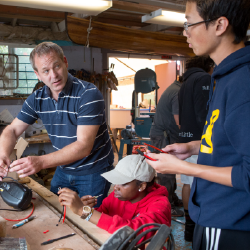Community Partnership
![]()
Future ready community partnerships include formal, informal, local, and global collaborative relationships that advance school to community networks and student learning goals. Face-to-face networking, communications through traditional and online communities, social media, and learning environments often serve as conduits for creating and sustaining community partnerships. Community partnerships extend students’ opportunities for learning far beyond the school walls and the limits of the school day by creating connections between the school, local businesses, organizations, caregivers and families, faith based institutions, and all education stakeholders. These partnerships also help to integrate other important components of students lived experiences into their learning process.
Local and Global Community Engagement and Outreach
Future Ready Schools® serve as hubs in their communities. Through collaborative partnerships, the term “lifelong learner” propels community and education entities to connect and (1) address digital equity by extending learning into community centers, libraries, businesses, institutions of higher education, museums, and other public spaces; (2) bring relevance to curricula through diverse learning opportunities like apprenticeships, mentoring, community service, and the use of community-based experts and resources; (3) implement community-based and virtual exhibitions, reviews, critiques, and celebrations of student, faculty, and stakeholder work; and (4) coordinate programs that encourage collaborations across campus, community, age, curricula, and cultures.
Local, Global, Cultural Diversity
Community partnerships provide integrated services that enhance student learning and decrease academic gaps between high-performing and low-performing students. School leaders leverage global partnerships to extend students’ knowledge, understanding, and appreciation of diverse cultures and communities, to support inclusivity. Local partnerships offer both face-to-face and virtual learning opportunities that further develop the capacity of faculty, students, and stakeholders to expand the learning experience and create relevant content. Furthermore, community partnerships engage external stakeholders in the learning process to create an environment that embraces diversity and enables more respectful, participative, and robust school-to-community relationships.
Learner-Centered Environments as Connectors to Local and Global Communities
Future Ready Schools® create technology-enabled environments through which all students have reliable access to devices, virtual communication, resource libraries, and other tools necessary for a collaborative learning experience. These tools support agile learning and appropriately facilitate local and global interactions such as those among peers, educators, caregivers, families, students, and stakeholders. Future ready leaders construct environments that value literacy, safety, and security through ongoing digital citizenship curricula.
College and Career Readiness
Through community partnerships, future ready leaders create networks that expose students to hands-on learning opportunities enabling them to apply classroom content to authentic contexts and various career fields. In developing relationships with industry experts and other community members, future ready leaders create learning experiences that engage outside audiences in the effort to motivate, challenge, and prepare students to pursue career paths piqued by their unique passions, talents, and interests.
Home and Community Communication and Engagement
Future ready leaders engage and encourage frequent and open school-to-home and community-to-home communication with families, caregivers, students, and stakeholders through a variety of channels. As active and invested community members, it is imperative that future ready leaders leverage avenues of communication appropriate to their respective communities. These may or may not include traditional communication methods such as newsletters and town hall meetings as well as internet-based solutions that require connectivity.
District and School Brand
Branding is defined as the marketing practice of creating a name, symbol, or design that identifies and differentiates one product from others. In a school context, it is critical that Future Ready Schools® develop a brand: one that represents visionary thinking and learner-centered approaches. The brand should be transparent to all members within the organization, who all tell the same story, one in which they believe and support. The brand is shared consistently and widely, is evident in all school communications, activities and events, and is easily understood and recognized by community members.
Featured Resource
[Webinar] Building Strong Community Partnerships
Strong family-school-community partnerships are critical when transitioning to student-centered learning.
Implementation Guide
Community Relations Plan
Effective leadership requires the ability to engage stakeholders effectively by building and managing relationships.
